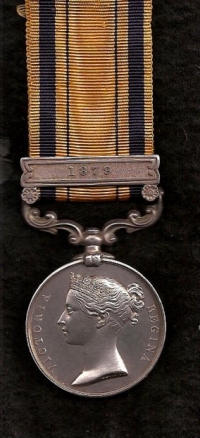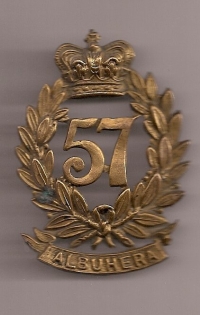SOUTH AFRICA MEDAL (1877-79)
CLASP 1879
To: 1265. Pte. E. SWIFT. 57th Foot.
"THE DIE HARDS".
Private Swift Took part in *The Battle of Gingindlovu against 11,000 Zulus on 3rd April 1879 under the command of Lord Chelmsford..
(Roll Confirms).
" On 1st April 1879, Lord Chelmsford’s column reached the Kraal of Gingindlovu and camped for the night. A very heavy rain came on and ground conditions were shocking. Lord Chelmsford had learned much from the lessons of Isandlwana and Rorke's Drift and thus at every subsequent encampment the stores and wagons were carefully positioned to create an unbroken defence wall and the troops dug out sections of trench around the square encampment. Every camp was thus made totally defensible in case of sudden attack.
Chelmsford’s chief scout, John Dunn, a long time inhabitant of Zululand, crossed the Nyezane River and beyond it saw the massed Zulu Army of some 11,000 warriors. Dunn returned to camp and reported that the Zulus would certainly attack in the morning. Chelmsford’s column was lcamped on the top of the hill, with sides sloping away in each direction. This was as good a position as any for defence in the upcoming battle and follwing the new standing orders, the camp entrenched in a classic square configuration.
The north face of the square was held by the 3rd Bn, the 60th Rifles; the left by the 99th Regt and the Buffs (3rd Foot) . The right face was held by the 57th Regiment. The squares corners were reinforced by Gatling Guns, normal small artillery and rockets.
As the sun came up horse and infantry piquets patrolled down towards the Nyezane River, looking for the Zulu advance. The regiments in the camp stood to at 4:00am. Shortly before 6am, reports came in from the advanced scouts of the approach of masses of Zulu warriors. A native soldier poining to the skyline shouted “Impi”. The officers stared at the hill top before realising that what they had assumed to be a long band of hillside vegetation was in fact the masses of advancing Zulu warriors who opened fired from light cover as they sped forward.
The first attack was defended by the 60th Rifles. This being one of the newly arrived regiments, the young soldiers of the 60th found the ordeal of the Zulu attack difficult in the extreme and it took great powers of leadership from the battalion’s officers to hold the line steady and firing. The Gatling guns at the corners of the encampment provided great support.
After much heavy fire from the British defenders the Zulu charge faltered and started to move around to the west flank of the square, where an attack was started against the 99th Regiment. In the face of the constant firing from the two sides of the square the Zulus finally sought cover and went to ground .The main thrust of the Zulu advance quickly moved around the back of the British position expecting to find the rear open, as it had been at Isandlwana, but in this caase the square was complete and they meet a searing volley of firing from the 91st Highland Regiment and here also the Zulus were forced to take cover. In the face of the constant and withering fire from the 91st, the Zulu attack on the rear of the camp faded away and Lord Chelmsford ordered his mounted troops out of the square to complete the dispersal of the natives. The mounted attack was however somewhat premature and it was to be some considerable time before the Zulu withdrawal finally became complete.
Just after 7am the battle was finished with the Zulus in total retreat, pursued by the mounted troops and the loyal native contingent. Very substantial numbers of Zulu warriors were killed in the pursuit and as at Khambula the unfortunate Zulus who were wounded on the battlefield were massacred.
The outcome of the battle was a point of great satisfaction to Chelmsford, showing him that the British Army’s confidence was being re-established and this enabled him to continue his advance to Pearson’s camp and onward to defeat the Zulu's King Cetshwayo, at the Battle of Ulundi."
*This battle took place some 9 weeks after the disasters at Isandhlwana and Rorke's Drift.
A SUPERB 'SPECIMEN' MEDAL FROM ONE OF THE MOST COLLECTED UNITS IN THE BRITISH ARMY
"THE DIE HARDS" MEDAL IS IN PRACTICALLY MINT STATE.
SOLD
With Matching Period Victorian Regimental (Brass) Helmet Badge
SOLD

